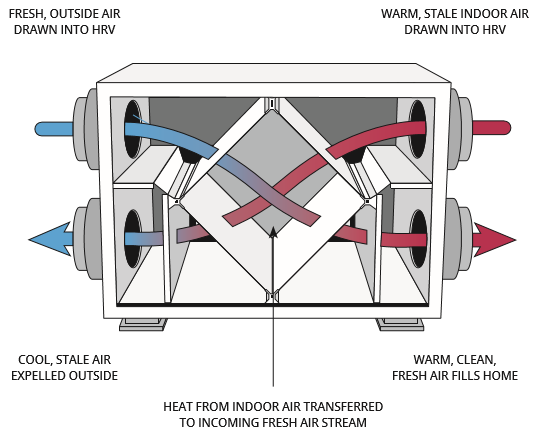Misconceptions About HRV That Homeowners Should Understand
Wiki Article
The All-Inclusive Overview to the Uses of Heat Recovery Ventilation in Modern Buildings
Heat Recovery Ventilation (HRV) systems stand for a substantial development in building modern technology (HRV Heat Recovery Ventilation). They offer a method for trading stale interior air with fresh outside air while decreasing power loss. This approach not just enhances indoor air high quality yet likewise adds to power effectiveness in both household and business structures. Comprehending the various applications and advantages of HRV can expose its critical duty in modern style and sustainability initiatives. The ramifications of this technology are worth discovering furtherRecognizing Heat Recovery Ventilation Systems

Several modern buildings prioritize power efficiency, comprehending heat recovery ventilation (HRV) systems is crucial for enhancing interior air top quality and minimizing power consumption. HRV systems work by transferring heat from stale indoor air to incoming fresh air, efficiently keeping comfy interior temperatures while minimizing energy loss. These systems consist of a warm exchanger, fans, and ductwork that help with the flow of air. During winter season, HRV systems capture and recycle warm from the outbound air, while in summertime, they can help cool inbound air. By constantly exchanging air, HRV systems additionally minimize moisture and the concentration of indoor contaminants. Correct installment and upkeep of HRV systems are important for their effectiveness and efficiency in enhancing overall structure efficiency and comfort.
Benefits of Heat Recovery Ventilation
Heat recovery ventilation systems offer many benefits that enhance both energy performance and interior air quality in modern structures. By catching and reusing power from exhaust air, these systems greatly decrease home heating and air conditioning prices, causing lower energy consumption. They maintain a constant circulation of fresh outside air, minimizing the threat of interior air contaminants and allergens. This continual exchange helps regulate moisture levels, preventing mold growth and ensuring a much healthier living environment. In addition, HRV systems contribute to sustainability objectives by decreasing general carbon footprints. Their capability to optimize ventilation without sacrificing thermal convenience makes them an important enhancement to modern building layout, advertising both financial and environmental benefits.Applications of HRV in Residential Structures
As property owners increasingly prioritize power efficiency and interior air top quality, the applications of heat recuperation air flow (HRV) systems in household structures have actually ended up being much more prevalent. HRV systems are particularly helpful in snugly sealed homes, where maintaining fresh air flow is crucial for preventing wetness build-up and indoor contaminants. They properly move heat from outgoing stale air to incoming fresh air, minimizing energy expenses linked with heating & cooling. Furthermore, HRVs can improve convenience degrees by managing moisture and temperature level. They are likewise adaptable for different residential layouts, consisting of single-family homes and multi-unit buildings. Generally, integrating HRV systems supports sustainable living practices while guaranteeing a healthier indoor environment for occupants.HRV in Business and Commercial Settings
In industrial and industrial setups, the application of warmth recuperation air flow (HRV) systems has become significantly critical for maximizing energy efficiency and preserving air high quality. These systems properly move warm from exhaust air to incoming fresh air, decreasing the demand for extra heating or air conditioning. This not just decreases energy prices yet also contributes to sustainability campaigns. Industries such as manufacturing, warehousing, and workplace structures benefit considerably from HRV systems, as they Resources assist regulate temperature and moisture degrees, ensuring try here a comfortable and effective environment. HRV systems aid in eliminating contaminants and excess wetness, enhancing indoor air top quality. As policies around air high quality become more stringent, the adoption of HRV innovation is most likely to grow, making it an essential element of modern industrial and industrial facilities.Future Fads in Heat Recovery Ventilation Technology

Frequently Asked Inquiries
Just How Does Heat Recovery Ventilation Effect Indoor Air High Quality?
Heat recovery ventilation considerably improves indoor air quality by continually trading stagnant interior air with fresh outside air while recuperating energy. This procedure minimizes toxins, maintains ideal humidity levels, and assures a healthier setting for occupants.Can HRV Solutions Be Mounted in Existing Buildings?
HRV systems can without a doubt be mounted in existing buildings. Retrofitting might need modifications to ductwork and air flow formats, yet it substantially improves power efficiency and interior air quality, making it a viable option for older frameworks.What Upkeep Is Needed for HRV Solutions?

Are There Certain Climates Where HRV Is Extra Reliable?
Heat recovery ventilation systems are especially efficient in environments with substantial temperature differences between seasons. These systems enhance energy performance by recuperating warmth from exhaust air, making them ideal for both chilly and reasonably warm settings.How Do HRV Systems Affect Energy Costs?

Report this wiki page